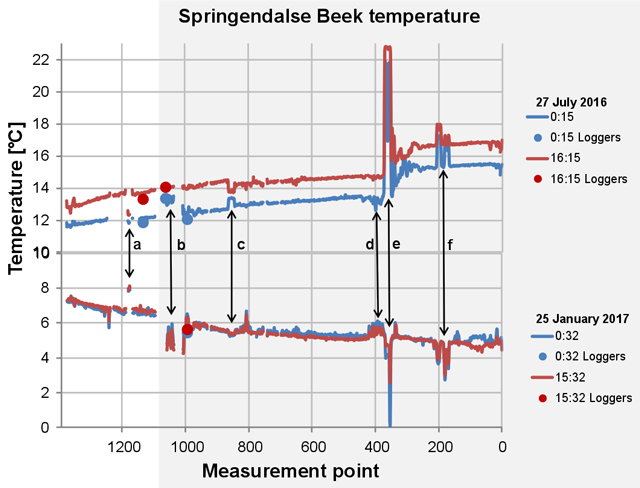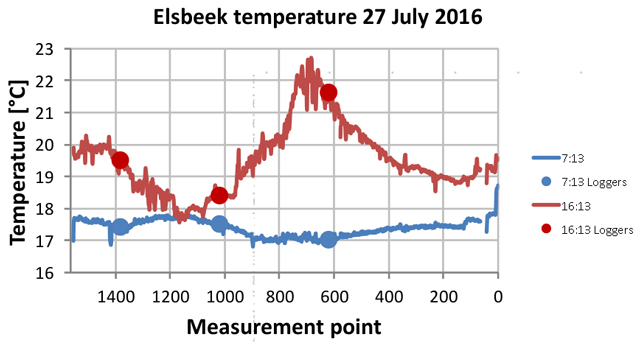Knowledge journal / Edition 2 / 2017
Monitoring with fibre-optic cables in streams shows local effects and heterogeneity in water temperature
The water temperature is a determining factor for the ecological functioning of streams. The stream temperature was continuously monitored in two streams in Twente using long fibre-optic cables.
The water temperature in streams influences (bio)chemical processes, the presence of species and the functioning of ecosystems. The water temperature of streams is influenced by processes both at the surface and subsurface. On one hand, the air temperature and direct or diffuse radiation causes heating or cooling, whilst on the other hand seepage and diffuse exchange with the stream bed result in regulation of the water temperature.
There is currently little knowledge about the interplay between these local processes and particularly the role of seepage, despite the fact that temperature is an important factor for the surface water quality. Insight into the heat budget of stream systems is required in order to be able to take the right steps to manage the stream temperature and therefore the ecology, particularly in view of future climate change.
Temperature measurements with fibre-optic cables were carried out in order to locate seepage and understand the role of seepage on stream temperature in relation to other factors. This technique - Distributed Temperature Sensing (DTS) - was used to measure temperature continuously in both time and space . This way, the spatial changes in the water temperature as a result of differences in morphology, flow speed and riparian vegetation were measured, together with the effect of local seepage. These measurements were carried out within the European MARS project, within which research is done on the effect of combinations of stressors on aquatic ecology. Between summer 2016 and the start of 2017 the DTS temperature measurements were carried out in two streams in Twente: the Elsbeek at Losser and the Springendalse Beek. Fibre-optic cables with a length of 1.5 km were placed in the streams which collected the water temperature each metre of the cable every half hour.
Springendalse Beek: a spring-fed stream
The Springendalse Beek springs on the Ootmarsum moraine, and flows through the nature reserve ‘Het Springendal’ for the first 2 km. The area features a number of seepage-lakes which discharge into the stream. The measurements were carried out from approximately 250 m from the source of the stream to around 1400 m downstream. Figure 1 shows the day and night water temperature for a warm summer day and a cold winter day.
 Figure 1. Day and night temperature measurements of the Springendalse Beek from upstream to downstream (left to right) in both summer and winter show the influence of a tributary (b), seepage-lake (c,e,f) and groundwater seepage (a, d). At these locations the temperature either makes a step or has a different warming/cooling pattern. The dots are measurements from independent temperature loggers.
Figure 1. Day and night temperature measurements of the Springendalse Beek from upstream to downstream (left to right) in both summer and winter show the influence of a tributary (b), seepage-lake (c,e,f) and groundwater seepage (a, d). At these locations the temperature either makes a step or has a different warming/cooling pattern. The dots are measurements from independent temperature loggers.
The measurements in Figure 1 start around 300 m downstream from the source of the stream, where the water temperature in both summer and winter is approximately 10 degrees Celsius. The cause of the constant temperature is that the groundwater has a temperature of around 10-11 degrees and does not fluctuate much over the year, and as a result of the large seepage flow this temperature is still present when the groundwater reaches the surface. On a warm summer day, the groundwater-fed stream heats up in the downstream direction while on a cold winter day the stream cools down.
A tributary enters the stream at point b. The area features a number of seepage-lakes, which are lakes fed by groundwater which discharge into the stream (Figure 1: c, d, f). The influence of the weather can be seen in these slowly draining lakes: in the winter the lakes are responsible for a cold inflow into the stream, and in the summer radiation from the sun causes the seepage-lakes to warm up, which is particularly clear at the 2nd source lake (Figure 1: e). What is noteworthy is that the 1st source lake also provides a cool inflow on a warm summer day (Figure 1: c). Measurements of the isotope Radon-222, which is an indicator of recent groundwater seepage, show that this temperature difference is the result of the fact that the water spends a shorter time in the 1st source lake than in the 2nd source lake, and is therefore heated less by radiation and warm air. The 2nd source lake is much larger and deeper than the 1st source lake.
A significant inflow of groundwater can be identified from the measurements because the stream cools in summer and warms up in winter. The difference in the temperature of seepage can clearly be seen at location a in Figure 1, where the fibre-optic cable is looped through a spring directly next to the stream which provides a more constant water temperature. Variations in the stream's heating/cooling curve indicate that significant seepage is taking place and can be seen at various locations in Figure 1: around the spring at a where the cooling is diminished in winter, downstream of source lake c where the temperature rises in winter, and at point d where the stream stops warming in summer and the temperature increases rather than decreases in winter.
Vertical temperature measurements in the stream bed and measurements with seepage meters in Het Springendal showed seepage fluxes of 86 to 490 mm/d. One important observation from these measurements is that there is great heterogeneity within a stream profile: there are locations where seepage takes place around one bank of the stream whilst water infiltrates on the other side. Measurements with Radon-222 also confirm the influence of seepage.
Temperature measurements in the Springendalse Beek show clear differences. The upstream part has a maximum summer temperature of 14 degrees, and is above 6 degrees on a cold winter day. On these days the downstream part warms up to 17 degrees and cools to around 5 degrees. The constant flow and constant lower temperatures resulting from the supply of groundwater mean that the upper reaches feature cold stenothermic species such as the stone flies Nemoura cinerea and Amphinemura standfussi and the midges Heterotanytarsus apicalis and Heterotrissocladius marcidus (Verdonschot et al., 2002).
The Elsbeek at Losser: a stream through varying agricultural terrain and woodland strips
The Elsbeek at Losser is a typical Dutch lowland stream which primarily flows through agricultural terrain. The measurements in the Elsebeek particularly show the effect of shade: where the stream flows through open fields, it warms by a couple of degrees, after which the stream cools again in the shaded areas (Figure 2). In this, the speed of flow, the depth of the stream and the occurrence of pools are also important. Between 1400-1200 m the stream has deep, slow-flowing pools, which cause cooling because the water temperature is buffered throughout the day in this body of water. In the open area between 900-800 m the stream warms up, and this warming accelerates between 800-700 m when the stream passes through an open and more slowly flowing part. After this, the water cools down again in the wooded area. Unlike the Springendalse Beek, the DTS measurements show no clear influence of seepage on the temperature of the Elsbeek. That is not to say that there is no seepage, just that it is too marginal for any effect on the water temperature because the seepage flow is too small in relation to the stream’s flow.
 Figure 2. Summer temperature measurements of the Elsbeek from upstream to downstream (left to right) show the influence of shade in conjunction with flow velocity and stream depth. The circles are measurements with independent temperature loggers.
Figure 2. Summer temperature measurements of the Elsbeek from upstream to downstream (left to right) show the influence of shade in conjunction with flow velocity and stream depth. The circles are measurements with independent temperature loggers.
The measurements in the Elsbeek show that the temperature can vary significantly even over small stretches as a result of flow speed, depth and shade. Seepage measurements in November 2016 showed a seepage flow in the downstream part of the Elsbeek of around 150 mm/day, but no seepage or even infiltration were measured in other parts of the stream. Radon-222 measurements showed no significant seepage, and the vertical temperature measurements showed great heterogeneity, like in the Springdalse Beek.
Groundwater and surface processes steer the stream temperature
Whilst the measurements in Het Springendal show clear buffering of the temperature by groundwater, the temperature of the Elsebeek is mostly determined by solar radiation and air temperature combined with the stream's depth and flow speed. Groundwater causes a lower maximum temperature in the summer and higher minimum temperature in the winter. The measurements shows that the heterogeneity of the stream temperature is great, and this heterogeneity can be measured with the aid of DTS measurements. These anomalous locations and temperature extremes could actually provide specific habitatfactors which are required for (rare) aquatic species. Further analysis of the measurements will focus on the effect of shade and the quantification of the effect of seepage on the stream temperature.
Better understanding of the groundwater and surface water temperature contributes to achieving WFD targets, because more efficient restoration steps can be taken. Better system understanding can - for example - help guide the restoration or retention of ecologically favourable water temperatures in surface waters against the backdrop of a rise in temperatures as a result of climate change. To maintain seepage zones, which also have a positive effect on the base flow and water quality, it is important that groundwater is included in management plans. Alongside detecting seepage, the DTS technique can be used for many other applications such as identifying drying of streams, stagnation, sedimentation, (illegal) discharges, leaking sewers and the effect on water temperature of measures such as the planting of riparian vegetation.
Vince Kaandorp
(Deltares)
Perry de Louw
(Deltares)
Pieter Doornenbal
(Deltares)
Summary
The water temperature is a determining factor for the ecological functioning of streams. The stream temperature was continuously monitored in two streams in Twente using 1.5 km-long fibre-optic cables. Because seepage causes a buffering of the stream temperature, these measurements have been used to detect locations with significant groundwater seepage. Shade also has a clear effect on the stream temperature. It is important to manage stream water temperature in order to achieve WFD targets and make streams climate-proof. This technique allows the stream temperature to be measured on a fine scale, and provides insights into the heterogeneity of the stream temperature which is important when intervening in the water system.
Literature
Verdonschot, P.F.M., van den Hoek, T.H., van den Hoorn, M.W., 2002. De effecten van bodemverhoging op het beekecosysteem van de Springendalse beek (The effects of a raised bed on the stream ecosystem of the Springdalse Beek). Wageningen. doi:1075
Auteurs

Vince Kaandorp
(Deltares)

Perry de Louw
(Deltares)

Pieter Doornenbal
(Deltares)




